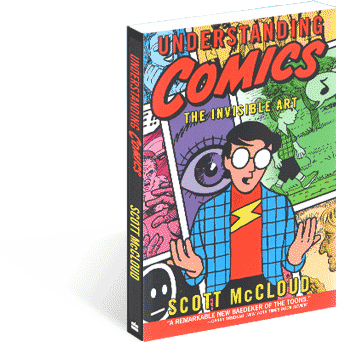Now this book isn’t a how-to book, in fact it doesn’t even scrape that topic, the entirety of it is dedicated to theories on why comics are a great (and often over-looked) artistic medium. Now comic theory is hugely complicated, it’s something that kept geniuses the world over up at night, but Scott tackles this in 9 different chapters
- 1. Placing an appropriate definition on comics
- 2. The Visual style of comics
- 3. Comic’s use of closure
- 4. How time is presented within Comics
- 5. How comics expresses emotion in its panels
- 6. How comics relies heavily not just on Images, but the written word as well
- 7. What comics has in common with other artistic mediums
- 8. Comics use of colour
- 9. What all this means (retrospective chapter)
While I could talk about the entire book, and comics, since this is a design blog I will talk about the chapter that is most relevant to all art these days.
What do you see? If you see a face, you are wrong. This is an image of a circle, two dots and a line. And yet, anyone you may ask will come up with the same answer. Why is this? Do we all have vision problems? Did our ancestors look like this? Well Scott came up with a very reasonable answer
 |
| He has all the answers…. Smug bastard |
His belief is that we see our self image as extremely simplified versions of ourselves, something along the lines of a simple minimalistic cartoon. Thus when we see a cartoon, we can see a person. Because of this we have a greater affinity for cartoon characters as we can more easily place ourselves in their shoes. Pure magic!
Scott wrote this book the intention of other have differing opinions, so I’ll throw my two cents in. I think his theory is close, but not quite right. For example, what do you see in this image?
A dog, correct? But based on Scott’s theory, that shouldn’t be, as we don’t see ourselves as simplified dogs, and yet we know that this image is of a dog. I believe that we simply are intelligent enough to know what an image is meant to be of. This may be because we’ve been drawing such things for thousands of years, it may be because we rule as a species (take that all other animals!)
However, because of the simplified nature of the characters, they appeal to us because they are vastly different from what’s around us. Thus we have a greater connection to them.
But regardless, this book is a great read, and if you enjoy comics it’s interesting to gain further insight into them, and into the aspects of them that you would have never thought about before hand.




No comments:
Post a Comment